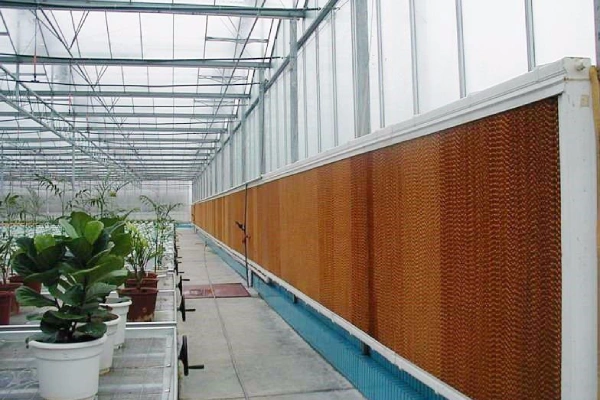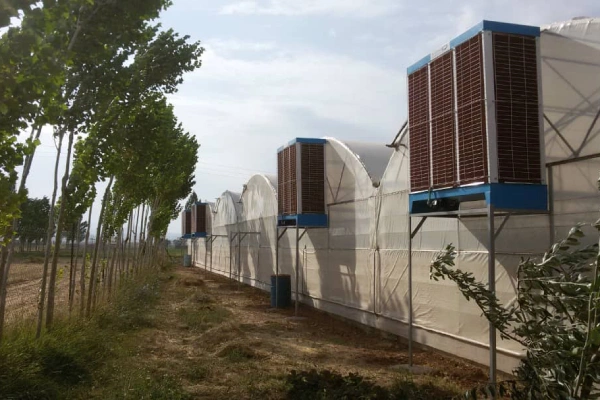Greenhouse cooling methods

Temperature control in greenhouses is of great importance. Inappropriate temperatures can seriously damage plant growth and reduce the quality and quantity of the product. One of the main challenges in greenhouse farming is dealing with excessive heat, which can be caused by direct sunlight, plant metabolic activities, and other factors. To deal with this challenge, various methods have been developed for cooling greenhouses, which we will discuss below. In this article, we will examine greenhouse cooling methods, including traditional and modern methods. We will also examine the advantages and disadvantages of each method and the factors affecting the selection of the best method for each greenhouse.
Table of contents
- Traditional Greenhouse Cooling Methods
- Modern Greenhouse Cooling Methods
- Choosing the Best Greenhouse Cooling Method
- Conclusion
- Alvand Industrial Group: Fresh Air for Your Business
Traditional Greenhouse Cooling Methods
Before the advent of modern technology, farmers used traditional methods to cool their greenhouses. Although these methods are not as efficient as today’s methods, they are still used in some cases alongside modern methods.

1. Natural ventilation
One of the simplest and oldest methods of cooling a greenhouse is to use natural ventilation. By opening the windows and vents of the greenhouse, the warm air inside is replaced with cooler air outside. The importance of natural ventilation is in providing the plants with the oxygen they need and reducing excessive humidity inside the greenhouse. However, the main limitation of this method is its high dependence on weather conditions and cannot effectively reduce the temperature of the greenhouse in all conditions.
How is fan power calculated and why is it necessary to know it? Click on the article in question to answer this question.
2. Shading
Shading using awnings, awning nets or special covers is another traditional cooling method. This method prevents the air temperature from increasing by reducing direct sunlight into the greenhouse. The main advantage of shading is its simplicity and low cost. However, the limitation of this method is the reduction of the light intensity required for photosynthesis of plants, which can negatively affect their growth.
3. Water sprinkling
Sprinkling water on the roof of the greenhouse or its surrounding area is an old method of cooling. As the water evaporates, the heat of the environment is absorbed and the air temperature decreases. The advantage of this method is that it increases the relative humidity of the air, which is beneficial for some plants; however, the disadvantages of water sprinkling include high water consumption, excessive humidity in some cases, and the possibility of fungal and plant disease growth.
Although traditional greenhouse cooling methods are simple and inexpensive, they have their own limitations. To achieve the best results, it is recommended to use a combination of traditional and modern methods.
How are industrial ventilation calculations performed? What are the calculation methods? You can go to the relevant article to answer your questions.
Modern greenhouse cooling methods
With the advancement of technology, new and more efficient methods of cooling greenhouses have been developed. These greenhouse cooling methods not only help reduce the temperature, but also regulate the relative humidity and provide a suitable environment for plant growth.

1. Evaporative Systems
One of the most common methods of evaporative cooling is based on the principle of water evaporation and heat absorption from the environment. Two main systems fall into this category:
Pad and fan: In this system, a cellulose pad soaked in water is placed on one side of the greenhouse and fans are placed on the opposite side. When the fans are turned on, air passes through the pad, absorbs moisture and is cooled. Then, cool air is blown into the greenhouse. The advantages of this system include: low installation and maintenance costs, humidification of the environment and reduction of air temperature.
Industrial water cooler: These coolers, with a much higher capacity than pad and fan, are suitable for large and industrial greenhouses. Their performance is similar to domestic water coolers, with the difference that their dimensions and power are much greater. In addition to cooling, industrial water coolers also purify the air.
Comparing pad and fan with industrial water cooler
| Feature | Pad and fan |
Industrial water cooler
|
| Capacity | Suitable for small and medium greenhouses | Suitable for large and industrial greenhouses |
| Cost | Lower | Higher |
| Humidification | Top | Medium |
2. Industrial Fans
Industrial ventilation fans are an essential tool for maintaining the desired temperature in greenhouses. By creating a strong and continuous air flow, these devices direct the hot and stagnant air inside the greenhouse to the outside and replace it with fresh and cool air. As a result, the temperature in the greenhouse is reduced and ideal conditions are provided for plant growth. In addition to reducing the temperature, fans also help maintain the appropriate relative humidity, reduce the accumulation of carbon dioxide and prevent the development of fungal diseases.

3. Misting Systems
Misting systems increase the humidity of the environment and reduce its temperature by spraying very fine water particles into the air. These systems are especially useful in greenhouses that require high humidity, such as mushroom greenhouses.
Comparison of misting systems with other methods
Advantages: Creating high humidity, reducing local temperatures, increasing product quality
Disadvantages: High water consumption, requiring constant maintenance, possible fungal diseases if humidity is not controlled
Choosing the best greenhouse cooling method
Choosing the most appropriate greenhouse cooling method is a key factor in the success of plant cultivation and breeding. This choice depends on several factors, each of which in turn affects the performance and efficiency of the cooling system. Factors affecting the selection of the appropriate method include:
Plant type: Each plant requires a specific temperature. Some plants require high humidity and lower temperatures, while others require higher temperatures and lower humidity.
Greenhouse size: For small greenhouses, simpler methods such as natural ventilation and shading are sufficient. However, for larger greenhouses, more advanced systems such as greenhouse pads and fans or industrial coolers are required.
Climate conditions: In hot and dry areas, evaporative methods such as pads and fans are more effective. While in more temperate areas, simpler methods can be used.
Budget: The cost of installing and maintaining each system varies. You should choose a system that fits your budget.
Combine methods for maximum efficiency
In many cases, using one method alone is not enough to provide the cooling needed for the greenhouse. Therefore, combining several methods may lead to better results.

For example, a pad and fan system can be used to initially cool the air and then industrial fans can be used to evenly distribute the air in the greenhouse. Also, using shading along with evaporative systems can reduce the workload of the cooling system.
To buy an industrial fan, if you need guidance on buying one, you can go to the article Industrial Fan Buying Guide.
Important points in choosing a cooling system
Consulting with an expert: Before choosing any system, it is better to consult with an agricultural expert or agricultural engineer.
Visit similar greenhouses: Visiting greenhouses that use similar cooling systems can help you make a better decision.
Pay attention to energy consumption: Choosing a system that uses less energy can reduce your costs in the long run.
Pay attention to maintenance and repairs: Choose a system that is easy to maintain and repair.
By considering all these factors, you can choose the best cooling system for your greenhouse and enjoy its benefits.
Conclusion
Greenhouse cooling is one of the key factors in increasing the productivity and quality of agricultural products. By choosing the right cooling method based on the type of plant, greenhouse size, climate conditions and budget, you can provide an ideal environment for plant growth. Traditional methods such as natural ventilation and shading, along with modern methods such as evaporative systems, industrial fans and foggers, each have their own advantages and disadvantages. The future of greenhouse cooling also promises to further improve the environmental conditions of greenhouses with the advancement of technology and the introduction of new methods such as the use of renewable energy and smart systems.
Alvand Industrial Group: Fresh air for your business
Alvand Industrial Group, relying on world-class technical knowledge, produces a wide range of air conditioning equipment. Alvand products, from powerful industrial fans to advanced heating systems, provide you with a healthy, safe and productive environment. By choosing Alvand, experience energy consumption optimization and increased work efficiency. For more information and to order products, contact the experts of Alvand Industrial Group now.




 2024-12-16
2024-12-16 31 minute
31 minute
 0 comment
0 comment